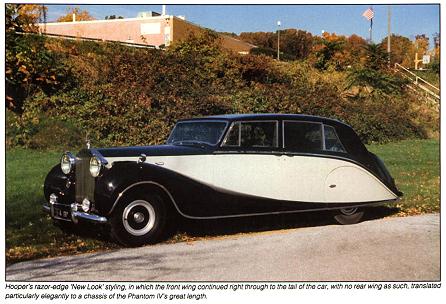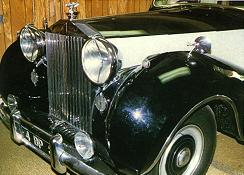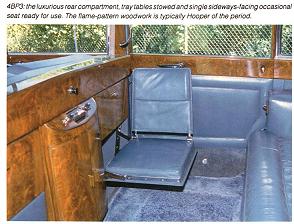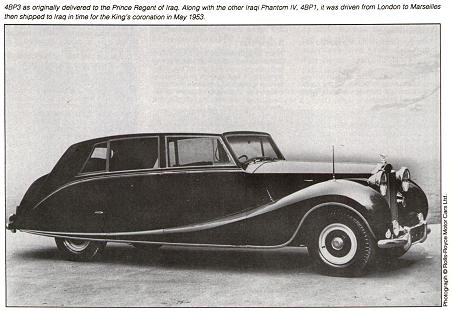From RROCA-info
4BP3
Impressions of a 1953 Phantom IV
By Matthew A. Sysak (Pennsylvania, U.S.A.), 1996
There are those of us in the Rolls-Royce and Bentley hobby who are fortunate enough to have a 'one-of-a-kind' motor car. This usually consists of unique coachwork on a chassis of which large numbers (by our standards) were produced. There are, however, those at the top of the food chain who not only have unique coachwork, but a very rare chassis type as well. Such are the owners of the Phantom IVs.
Only 18 of these chassis were ever produced, of which only 15 were sold new to customers. You had to be royalty or a head of state to even get an order accepted by the Factory. The Phantom IVs and their original owners are best detailed in Martin Bennett's Rolls-Royce and Bentley: the Crewe Years, starting on page 140.
Fortunately, two of them live near me in eastern Pennsylvania. Two local (within 125 miles) collector friends are each the proud owner of a Phantom IV and I have had the pleasure of closely inspecting both and driving one. After the 1993 R.R.O.C. Annual Meet in Asheville, your Editor Martin Bennett and I were fortunate to be able to pore over 4AF12, a Hooper limousine originally built for the use of Lord Hives, Managing Director of Rolls Royce Ltd, and later sold to Princess Marina.
The second car, 4BP3. is currently owned by Mr Robert Shaffner, an avid enthusiast who is very active in the hobby as Chairman of the Phantom III Technical Society and President of the R.R.O.C. Foundation. He acquired 4BP3 this summer. Upon finding out that he had purchased the car I telephoned him to congratulate him, whereupon he invited me to inspect, photograph and most importantly drive the car. It took no more time than that required for the synaptic response in my brain to occur before I accepted his generous offer.
By way of a little background, 4BP3 was originally built for the Prince Regent of Iraq and was fitted with Hooper touring limousine coachwork. It still carries the hand enamelled number plate bearing the royal crest, the numeral '1' in Arabic script and a likeness of the Prince Regent. The car was delivered by Hooper & Co. in March 1953 with body number 9891 to design number 8370, which is a one-off. According to Mr Shaffner, the car remained in the possession of the Iraqi royal household until after the revolution led by Saddam Hussein, the current leader of Iraq.
After weeks of anticipation we finally coordinated our schedules for late September. I decided that inasmuch as 4BP3 has a Hooper 'New Look' (still often erroneously termed 'Empress Line') body, I would drive my 1949 short chassis Silver Wraith (WGC 16) with the prototype 'New Look' coachwork for a side-by-side comparison.
Upon first seeing 4BP3 the initial impression is one of size. It is absolutely one of the largest cars I have ever seen. Yet, the design has been so skilfully executed that there is no sense of disproportionate bulk for the sake of sheer size, but more a tasteful design accommodating the massive chassis as well as the requirements of the owner. It is yet another testament to the excellent eye and superb taste of Osmond Rivers, Chief Designer at Hooper & Co. at the time.
When I looked at the photographs of my Silver Wraith, itself no small car, next to the Phantom IV it was easy to see why Phantom IVs are sometimes referred to as 'Silver Wraiths on steroids'. It is longer, wider, taller, heavier - and more powerful.
4BP3 is remarkably original, with a mileage from new of only 38,000. The exterior colours are black wings and above the waist line, with pale grey on the side panels in between. It was originally all black. There is a pin-stripe on either side of the chromium trim along the raised waist rail in a medium blue, matching the color of the hides. The paintwork is partly original but has, out of necessity owing to the tremendous variety of climates the cellulose has been subjected to, been repaired in places over the years. The workmanship has been first rate, however. The condition of the coachwork is excellent and completely original. This is to be expected with the car having been either in royal service or tucked away in the collections of several enthusiasts since its liberation from Iraq.
The remainder of the exterior is all original and in excellent condition with the exception of the driving lamp lenses which Mr Shaffner will be correcting in short order. One very interesting feature is the spats over the rear wheel arches. They are mounted on an extremely clever doublejointed pivot system. After moving a piece of chrome trim at the front of the spat, one inserts a carriage key into the slot for a quarter turn to undo the lock. A gentle pull at the bottom of the spat brings it away from the body, swivelling it up and back towards the rear of the car while at the same time rotating the large front of the spat up and away from the opening so as to allow complete access to the wheel. A gentle push down and in towards the wheel opening replaces the spat which then locks in place with a quarter turn of the key. A very tidy and ingenious system and a super bit of engineering.
Upon entering the car the first impression is one of enormous volume. Not only is there generous seat width but the height and depth of the rear compartment add to the voluminous feeling. Half the population of a small Third-world country could take up residence there, or so it seems.
The interior is all original with the leather, carpet, over-carpet and trim being coloured a shade of medium blue. The seats have obviously had great care over the years, remaining soft and supple and showing virtually no wear. The wood trim is as new. Sadly, the original headliner, which is in otherwise excellent condition, has suffered numerous moth holes and may be replaced by Mr Shaffner.
The car is fitted with Sundym glass all round which makes sense in light of the climate of the original owner's country. All of the windows as well as the division are electrically operated. There is a cabinet built into the back of the division but as the Prince Regent was a devout Muslim there is no provision for glasses or decanters. A radio is fitted in the top of the cabinet Inasmuch as the coachwork is described as a touring limousine, there is only one occasional seat, on the off-side facing the centre of the car. There are two folding tray tables at either side of the top of the cabinet. The rear seat has adjustments for both height and forelaft positions, as well as for the seat backs.
The chauffeur's compartment is standard Silver Wraith and is instantly recognisable as such - again except for the width and height. The seat is slightly adjustable fore and aft but the space between the steering wheel and the seat back is not well suited to persons of ample girth. So as to have the maximum amount of room Mr Shaffner has moved the seat back as far as is mechanically possible, but it would be impossible to gain any additional space without major work to modify the position of the division.
The boot is all original and still has the original factory-mounted spare tyre. It is the only area of the car that does not give the impression of being over-sized. This is due primarily to the enormity of the rear passenger compartment which encroaches rather far back into the boot area, and to the spare wheel which sits under a cover in the middle of the boot floor. The spare tyre is an enormous 8.00 x 17 Dunlop Fort 'C' and seemingly weighs a ton as I found when I removed it to photograph the road tool compartment underneath. All of the original road and hand tools are still with the car, as is the handbook. The handbook would be quite a complement to the collection of any RollsRoyce publications collector!
The engine compartment is another commodious statement. To work under the bonnet would require a small step-ladder to get up and over the high, wide wings and the high valence. Again, the engine compartment is almost pure Silver Wraith with the exception of those two extra cylinders, the distributor, exhaust manifolds and the oil-bath air cleaner not normally fitted to an early post-war car (except for export to dusty areas -my Silver Wraith WHD101 has this feature. - Ed.). The carburetter is the same as on my Silver Wraith, namely a Stromberg type AAV-26. Again, the engine and compartment are in excellent condition and want only for a very minor tidying up.
The highlight of the visit came after all the inspecting and photography. I now got to drive this interesting piece of motoring history. She starts just like any Silver Wraith but one very quickly notices the different exhaust note. Forgive the comparison but as the former owner of many straighteight Buicks, the tone was unmistakable. A very soft and smooth purr. There is no other engine configuration that sounds like it. It is perhaps the pleasantest internal combustion exhaust sound ever.
Once she was warm and off the automatic choke, she ticked over as one would expect and was stone silent. I climbed (well, more like wedged myself behind the wheel, depressed the clutch, engaged first, and off we went. Again, the feel is much like a Silver Wraith. Even though there are two extra cylinders with the added horsepower and torque, one needs to bear in mind that this is a very large and heavy automobile. The extra weight and the extra power simply cancel each other out in the car's performance.
The non-assisted steering and gearbox are, again, very much like those of the Silver Wraith, being very smooth and requiring little effort. Upshifts were made very quickly, and you can be in top gear at 15-20 m.p.h. and on level road you can just leave it there. I don't know whether it was psychological or real, but there is a feeling of great bulk and weight - in absolute silence mind you but there is definitely a ponderous quality to the drive, although the car's road manners are impeccable. One can't help having Queen Mary-ish thoughts when driving this car, such is its presence on the road. We did not take the car onto any major highways but she accelerated effortlessly up to 50 m.p.h., which was as fast as I took her. Not a drag racer, but with an excellent performance given her size, weight, age and original purpose. One quickly assumes a 'regal' driving mode when behind the wheel of this car so that the car is never pushed anywhere near the outer limits of its capabilities.
The brakes were perfectly fine for the type of driving we did and never seemed to be less than up to their task. Very smooth and effortless with the fine Rolls-Royce mechanical servo. All in all, a wonderful drive and we returned her to the safety of her garage.
In my analysis of the many collector cars of all types that I have had the pleasure of driving boils down to one major factor: how they would be as 'touring' cars. In the case of 4BP3, save for the petrol costs, it would make an excellent car to tour with. There is one proviso, which applies equally to many pre-war formal cars, and that is that one would need to fit behind the wheel! Other than that, there is ample room in 4BP3 and its driving qualities, mechanical dependability and comfort would make for very enjoyable long distance travel.
Although the car was designed primarily for slow, formal state occasions, the flexibility offered by the chassis and coachwork affords the owner the best of both worlds.
Mr Shaffner intends driving 4BP3 to the R.R.O.C. Inc. Annual Meet in southwestern Virginia scheduled for July 21st-26th, 1997. Those of you who can attend will see her there and be able to view a true ne plus ultra motor car. Silver Wraith on steroids, indeed!
Photographs by the Author
Technical Specification, 4BP3 (1953 Phantom IV)
- ENGINE
- Eight cylinders in line. Bore 3� (89 m.m.), stroke 4�" (114 m.m.), cubic capacity 5,675 c.c. Compression ratio 6.4:1.
- Cylinder block/Crankcase
- Iron monobloc casting with pressed-in 30% chrome iron liners at tops of bores.
- Crankshaft
- 1% chrome molybdenum steel (EN.19) nitrided. Bolt-on balance weights. Nine copper-lead-indium main bearings. External rubber tuned harmonic balancer.
- Pistons
- Aluminium alloy (RR.43) tin plated. Granodised piston rings, one compression, one L-section and one slotted oil control ring.
- Cylinder head
- Aluminium alloy (RR.50) with inserted valve seats.
- Valve gear
- Overhead inlet, side exhaust valves. Exhaust valves in KE.965. Stellite coated seats and tips. Camshaft driven by helical gears, six bearings.
- Carburetter
- Stromberg type AAV-26 dual downdraught carburetter with accelerator pump and automatic choke. Water-heated hot spot. Oil bath type air cleaner.
- Ignition system
- Ignition by high tension coil and Delco-Remy distributor with twin contact breaker points. Spare coil fitted for emergency use. Firing order 1,6,2,5,8,3,7,4
- Lubrication system
- Helical gear oil pump in crankcase driven by skew gear from camshaft. Floating oil intake in sump incorporating gauze strainer. By-pass filter on side of cylinder block. Pressure relief valve incorporating high and low pressure feeds. High pressure to the main and big-end bearings and camshaft bearings, low pressure to valve gear and timing gears. Sump capacity 18 pints (2.7 U.S. gallons, 10 litres).
- Cooling system
- Radiator shutters controlled by thermostat in header tank. Auxiliary thermostat in cylinder head to give quickest possible warm-up from cold. Belt driven centrifugal coolant pump and fan.
- CHASSIS
- Overall length 19' 1 'h' (5,829 m.m.) Wheelbase 12' 1" (3,683 m.m.) Front track 4' 10�" (1,486 m.m.) Rear track EX (1,600 m.m.) Chassis weight 3,304 lb. (1,499 kg.)
- Frame
- Channel section frame of riveted construction with cruciform centre bracing and crossmembers. Box section pan to support front suspension components. Wilmot Breeden heavy export type bumpers and overriders.
- Suspension
- Front: independent by coil springs and rubber bushed wishbones, double acting hydraulic dampers and anti-roll bar. Rear: semi-elliptic leaf springs protected by leather gaiters, controllable hydraulic dampers by an oil pump mounted on the gearbox and an overriding control on the steering wheel boss.
- Steering
- Marles type cam and roller. Fore and aft side steering tube (drag link) to centre steering lever pivoted on front chassis cross member and two-piece cross steering tube (track rod). Turns lock to lock, 3� Righthand steering.
- Transmission
- Four forward speeds and reverse. Righthand change. Synchromesh on second, third and top gears. Ratios: Top 1:1, Third 1.343:1, Second 2.02: 1, First 2.985: 1, Reverse 3.15: 1. Single dry-plate clutch.
- Two-piece propeller shaft with needle roller bearing universal joints and centre bearing. Rear axle: semi-floating type with hypoid gears. Ratio, 4.25:1.
- Brakes
- Hydraulic front, mechanical rear. Operation by means of friction disc servo on the offside of the gearbox, which applies the front brakes through a Lockheed master cylinder and assists the application of the rear brakes. Handbrake on rear wheels by pullout handle under right side of fascia through a cable and mechanical linkage.
- Exhaust system
- Twin pipe system With four lagged expansion boxes and single tail pipe.
- Centralised lubrication system
- All bearings in the steering and suspension systems, including the rear spring main leaf and shackles, fed with oil from a reservoir and pump mounted on the bulkhead in the engine compartment. Pump operated by a pedal under the fascia.
- Fuel system
- Rear mounted petrol tank with filler neck on left side of the car, capacity 23 gallons (27.6 U.S. gallons, 104.5 litres). S.U. dual fuel pump set mounted in chassis frame. Filter between tank and pumps.
- Electrical system
- 12 volt positive earth system with 78 amp/hour battery. Lucas Special Equipment dynamo and starter motor with reduction gearing and gentle-engagement pinion. Lucas R.100 headlamps. Twin Lucas fog lamps. Radiomobile radio with push-button tuning and two speakers. Electrically operated windows and division.
- Other accessories
- Trico vacuum operated windscreen washing equipment.
- Road wheels and tyres
- 17 inch steel disc wheels with semi-drop centre rims, on ten studs, carrying 8.00 x 17 Dunlop Fort 'C' tyres. Ace 'Super Silent' discs. Spare wheel in boot. Tyre pressures (cold): 28 lb./sq. in. front. 36 lb.lsq. in. rear.
- COACHWORK
- Coachbuilder: Hooper & Co. Body style: 'New Look' touring limousine. Body number: 9891. Design number: 8370.







